Articles
- Page Path
- HOME > J Korean Acad Nurs > Volume 42(7); 2012 > Article
-
Original Article
- Effectiveness of Home Health Care Service for Elders after Spinal Surgery
- Myunghee Jun, Ji Young Jung
-
Journal of Korean Academy of Nursing 2012;42(7):1009-1018.
DOI: https://doi.org/10.4040/jkan.2012.42.7.1009
Published online: December 31, 2012
1School of Nursing, Daejeon University, Daejeon, Korea & University of Wisconsin-Milwaukee, Milwaukee, USA.
2Department of Nursing, Wonkwang Health Science University, Iksan, Korea.
- Address reprint requests to : Jung, Ji Young. Department of Nursing, Wonkwang Health Science University, 344-2 Sinyong-dong, Iksan, 570-750, Korea. Tel: +82-63-840-1318, Fax: +82-63-840-1319, jio110@wu.ac.kr
© 2012 Korean Society of Nursing Science
Abstract
-
Purpose
- This study was done to evaluate effectiveness of home healthcare services (HHCS) specialized for elders who received spinal surgeries.
-
Methods
- A non-equivalent control group pre-post test quasi-experimental study was performed. HHCS was developed based on the Rice model of dynamic self-determination for self-care. For data collection, a control group (n=23) and an experimental group (n=23) were selected by matching age, BMI, pain, general characteristics and type of spine surgery. Measurement tools to evaluate uncertainty and knowledge were developed by the authors. The Numeric Rating Scale (NRS) and Japanese Orthopedic Association Back Pain Evaluation Questionnaire (JOABPEQ) were used to evaluate pain levels. Muscular strength in the legs was measured using a digital muscle tester and tape ruler. Questionnaires were used to evaluate disability in performing ADL and psychological distress levels.
-
Results
- The experimental group showed significant decrease in uncertainty (p=.028), increased knowledge (p=.038), and partially decreased pain (p=.003-.331). Partial muscle strength increased significantly (p=.021-.644). Disability in performing ADL and psychological distress in the experimental group decreased significantly compared to control group (p=.002, p=.004).
-
Conclusion
- Results indicate HHCS is an efficient home care nursing program for these elders. Further experimental studies with larger samples are required to confirm effects of HHCS.
INTRODUCTION
METHODS
MEASUREMENTS
PROCEDURE
ANALYSIS
ETHICAL CONSIDERATION
RESULTS
DISCUSSION
CONCLUSION
This work was supported by the National Research Foundation of Korea (NRF) grant funded by the Korean government (MEST)(No2010-0016863).
- 1. Choi WJ, Kim DO, Jun MH, Jung JY. A comparative study of the level of pain, knowledge, and uncertainty between pre and post spinal operation. Poster session presented at the International Council of Nurses. 2011;05;Malta.
- 2. Cohen J. A power primer. Psychol Bull. 1992;112(1):155–159. http://dx.doi.org/10.1037/0033-2909.112.1.155.ArticlePubMed
- 3. Deyo RA. Back surgery-who needs it? N Engl J Med. 2007;356(22):2239–2243. http://dx.doi.org/10.1056/NEJMp078052.ArticlePubMed
- 4. Djurasovic M, Glassman SD, Carreon LY, Dimar JR. Contemporary management of sumptomatic lumbar spinal stenosis. Orthop Clin North Am. 2010;41(2):183–191. http://dx.doi.org/10.1016/j.ocl.2009.12.003.PubMed
- 5. Fukui M, Chiba K, Kawakami M, KiKuchi S, Konno S, Miyamoto M, et al. JOA back pain evaluation questionnaire(JOABPEQ)/JOA cervical myelopathy evaluation questionnaire (JOACMEQ) the report on the development of revised versions April 16, 2007. J Orthop Sci. 2009;14(3):348–365. http://dx.doi.org/10.1007/s00776-009-1337-8.ArticlePubMed
- 6. Harvey CV. Spinal surgery patient care. Orthop Nurs. 2005;24(6):426–440.PubMed
- 7. Jun MH, Choi CR, Lim EJ. Experience of Korean elderly patients undergoing lumbar spinal surgery: Inventive adaptation to postsurgical lives. Poster session presented at the Canadian Association of Neuroscience Nurses 41st annual meeting and scientific sessions. 2010;06;Quebec, Canada.
- 8. Jun MH, Jung JY. A follow up study for elderly's disabilities in performing activities of daily life after lumbar spinal surgery. J Korean Acad Soc Nurs Educ. 2010a;16(1):140–149.
- 9. Jun MH, Jung JY. Elderly patient guide: Spinal surgery for low back pain. 2010b;Seoul, Daehak Publisher.
- 10. Jung JY. Effects of legs muscular strengthening exercises on pain, muscular strength of legs, disability of daily living activity, and isoenzyme of patients with lumbar spinal stenosis. 2010;Daejeon, Daejeon University. Unpublished doctoral dissertation.
- 11. Lee CS, Lee CG. Lumbar spinal disease beyond common sense, Tale about lumbar disc. 2000;Goyang, KSI.
- 12. Lee JN. The effect and client satisfaction of home care nursing services for the aging: Focused on the poor aged in Yongin. 2007;Youngin, Gangnam University. Unpublished master's thesis.
- 13. Lee JS. Easy prevention and treatment for lumbar disc. 2004;Seoul, Garim Publisher.
- 14. McClune A. Predictors of improved quality of life 12 months after lumbar spinal fusion surgery. 2001;Pittsburg, University of Pittsburg. Unpublished doctoral dissertation.
- 15. Mekhail N, Vallejo R, Coleman MH, Benyamin RM. Long-term results of percutaneous lumbar decompression mild for spinal stenosis. Pain Pract. 2012;12(3):184–193. http://dx.doi.org/10.1111/j.1533-2500.2011.00481.x.ArticlePubMed
- 16. Mishel MH. Uncertainty in illness. J Nurs scholarsh. 1988;20(4):225–232. http://dx.doi.org/10.1111/j.1547-5069.1988.tb00082.x.Article
- 17. National Health Insurance Corporation. Major operation statistics 2010. 2011;Retrieved April 30, 2012. from http://www.nhic.or.kr/portal/site/main/menuitem.b3d33d790bae4b404bf15151062310a0.
- 18. Nielsen PR, Jørgensen LD, Dahl B, Pedersen T, Tønnesen H. Prehabilitation and early rehabilitation after spinal surgery: Randomized clinical trial. Clin Rehabil. 2010;24:137–148. http://dx.doi.org/10.1177/0269215509347432.ArticlePubMedPDF
- 19. Rice R. Home care nursing practice: Concepts and application. 2006;4th ed. St. Louis, Mosby.
- 20. Saban KL, Penckofer SM. Patient expectations of quality of life following lumbar spinal surgery. J Neurosci Nurs. 2007;39(3):180–189. http://dx.doi.org/10.1097/01376517-200706000-00009.ArticlePubMed
- 21. Sobottke R, Aghayev E, Roder C, Eysel P, Delank SK, Zweig T. Predictors of surgical, general and follow-up complications in lumbar spinal stenosis relative to patient age as emerged from the spine tango registry. Eur Spine J. 2012;21(3):411–417. http://dx.doi.org/10.1007/s00586-011-2016-y.ArticlePubMedPDF
- 22. Statistics Korea. Population projections for Korea: 2010~2060. 2011;Retrieved June 21, 2012. From http://kostat.go.kr/wnsearch/search.jsp.
- 23. Statistics Korea. Housing census: 2010-2035. 2012;Retrieved April 26, 2012. From http://kostat.go.kr/portal/korea/index.action.
- 24. Suri P, Rainville J, Kalichman L, Katz JN. Does this older adult with lower extremity pain have the clinical syndrome of lumbar stenosis? JAMA. 2010;304(23):2628–2636. http://dx.doi.org/10.1001/jama.2010.1833.ArticlePubMedPMC
- 25. Yu YK, Kim SH. The effect of rehabilitation exercise program according to whether or not operation of Lumbar in patients with Low back pain. Exerc Sci. 2006;15(4):275–282.
REFERENCES
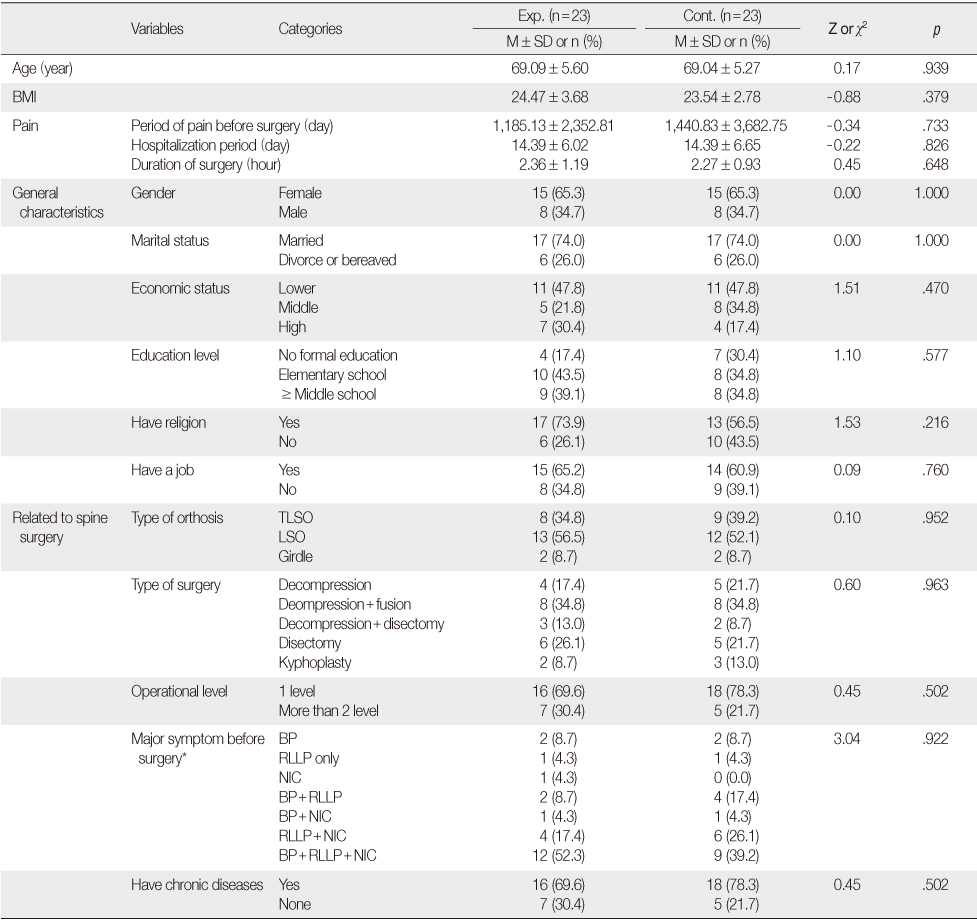
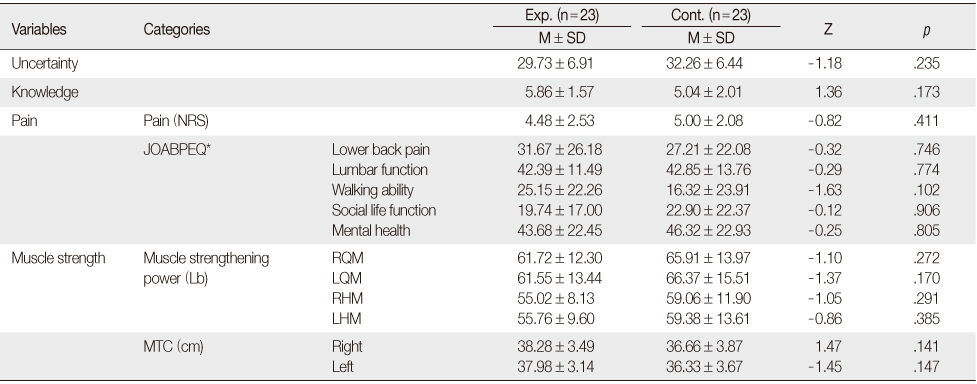
*2 cases of the control group were removed because total score were exceeded 90.
Exp.=Experimental group; Cont.=Control group; NRS=Numeric rating scale; JOABPEQ=Japanese orthopedic association back pain evaluation questionnaire;
RQM=Right quadriceps muscle; LQM=Left quadriceps muscle; RHM=Right hamstring muscle; LHM=Left hamstring muscle; MTC=Mid thigh circumference.
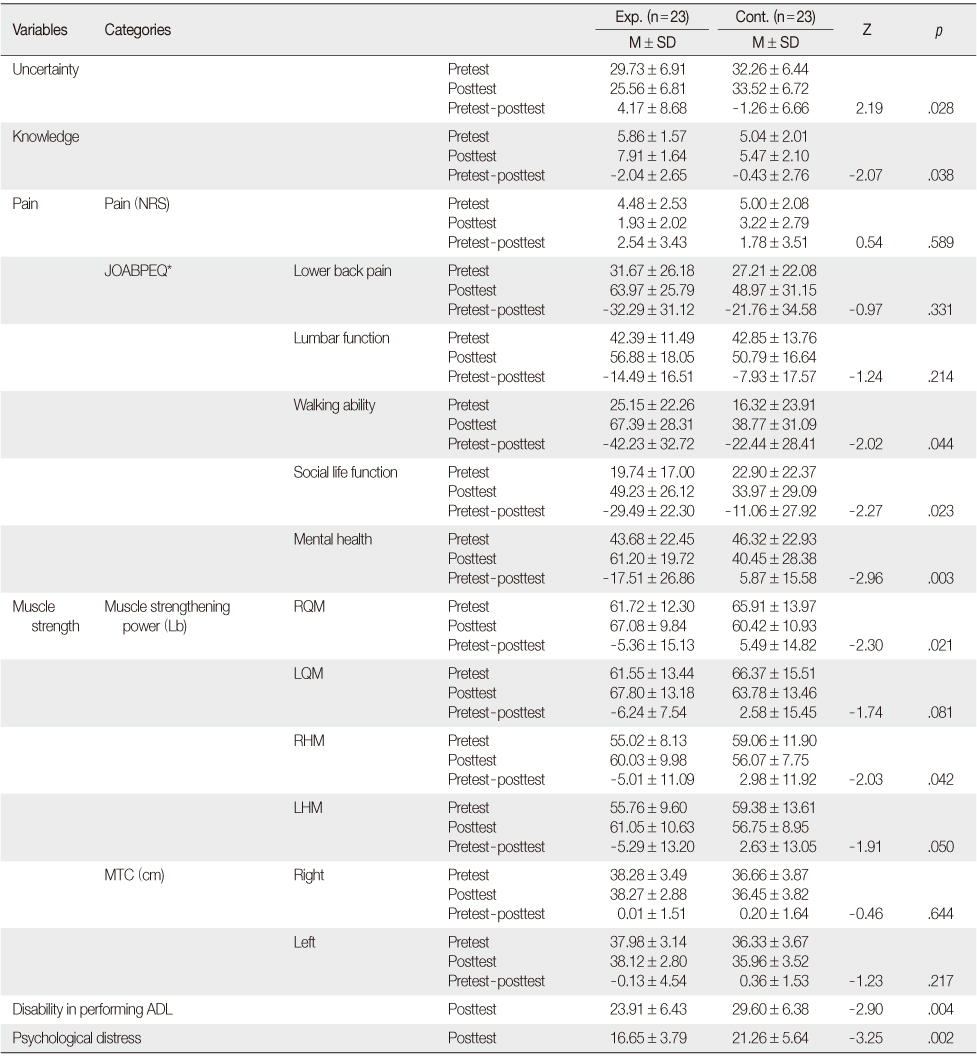
*2 cases of the control group were removed because total scores exceeded 90.
Exp.=Experimental group; Cont.=Control group; NRS=Numeric rating scale; JOABPEQ=Japanese orthopedic association back pain evaluation questionnaire; RQM=Right quadriceps muscle; LQM=Left quadriceps muscle; RHM=Right hamstring muscle; LHM=Left hamstring muscle; MTC=Mid thigh circumference; ADL=Activities of daily living.
Figure & Data
REFERENCES
Citations

- Development of multidisciplinary, evidenced-based protocol recommendations and implementation strategies for anterior lumbar interbody fusion surgery following a literature review
Richard Meyrat, Elaina Vivian, Archana Sridhar, R. Heath Gulden, Sue Bruce, Amber Martinez, Lisa Montgomery, Donald N. Reed, Peter J. Rappa, Hetendra Makanbhai, Kenneth Raney, Jennifer Belisle, Stacey Castellanos, Judy Cwikla, Kristin Elzey, Kristen Wilck
Medicine.2023; 102(47): e36142. CrossRef - Effects of Functions of Daily Living, Depression, and Anxiety on Catastrophizing Pain among Patients Undergoing Lumbar Spinal Surgery
Jeong Eun Yoon, Ok-Hee Cho
Journal of Korean Academy of Fundamentals of Nursing.2020; 27(3): 289. CrossRef - The effectiveness of home health care for reducing readmissions: an integrative review
Danielle M. Siclovan
Home Health Care Services Quarterly.2018; 37(3): 187. CrossRef - Factors Affecting Post-operative Uncertainty of the Patients Undergone Lumbar Spinal Surgery
Myunghee Jun, Jiyoung Jung, Minsuk Kim
Journal of muscle and joint health.2012; 19(3): 294. CrossRef
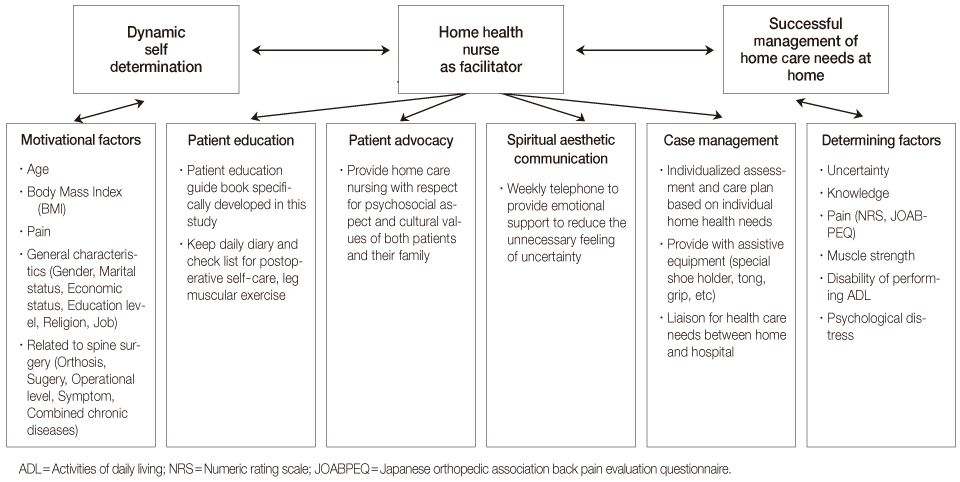
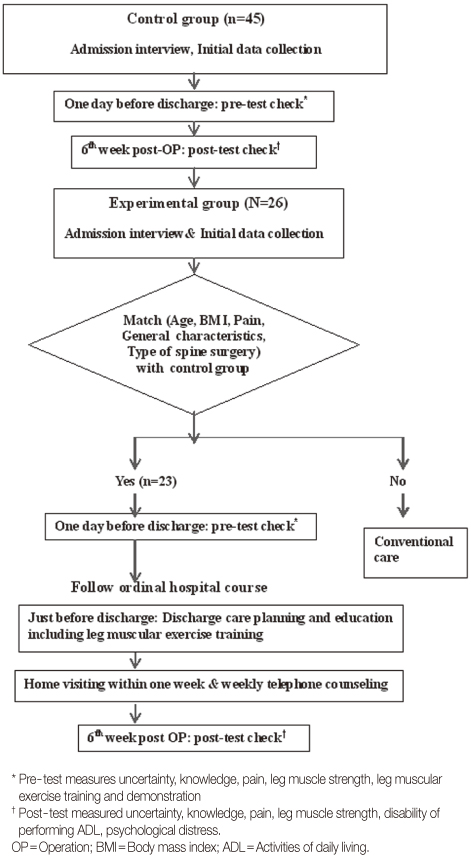
Figure 1
Figure 2
Homogeneity Test of Age, BMI, Pain, General Characteristics and related to Spine Surgery between Control and Experimental Groups (N=46)
Exp.=Experimental group; Cont.=Control group; BMI=Body mass index; TLSO=Thoraco lumbo sacral orthosis; LSO=Lumbo sacral orthosis; BP=Back pain;
RLLP=Radiating lower legpain; NIC=Neurogenic intermittent claudication.
*Fisher's exact test.
Homogeneity Test of Dependent Variables before Discharge between Control and Experimental Groups (N=46)
*2 cases of the control group were removed because total score were exceeded 90.
Exp.=Experimental group; Cont.=Control group; NRS=Numeric rating scale; JOABPEQ=Japanese orthopedic association back pain evaluation questionnaire;
RQM=Right quadriceps muscle; LQM=Left quadriceps muscle; RHM=Right hamstring muscle; LHM=Left hamstring muscle; MTC=Mid thigh circumference.
Effects of Home Health Care Service on Uncertainty, Knowledge, Pain, Muscle strength, Disability of Performing ADL and Psychological Distress (N =46)
*2 cases of the control group were removed because total scores exceeded 90.
Exp.=Experimental group; Cont.=Control group; NRS=Numeric rating scale; JOABPEQ=Japanese orthopedic association back pain evaluation questionnaire; RQM=Right quadriceps muscle; LQM=Left quadriceps muscle; RHM=Right hamstring muscle; LHM=Left hamstring muscle; MTC=Mid thigh circumference; ADL=Activities of daily living.
Exp.=Experimental group; Cont.=Control group; BMI=Body mass index; TLSO=Thoraco lumbo sacral orthosis; LSO=Lumbo sacral orthosis; BP=Back pain; RLLP=Radiating lower legpain; NIC=Neurogenic intermittent claudication. *Fisher's exact test.
*2 cases of the control group were removed because total score were exceeded 90. Exp.=Experimental group; Cont.=Control group; NRS=Numeric rating scale; JOABPEQ=Japanese orthopedic association back pain evaluation questionnaire; RQM=Right quadriceps muscle; LQM=Left quadriceps muscle; RHM=Right hamstring muscle; LHM=Left hamstring muscle; MTC=Mid thigh circumference.
*2 cases of the control group were removed because total scores exceeded 90. Exp.=Experimental group; Cont.=Control group; NRS=Numeric rating scale; JOABPEQ=Japanese orthopedic association back pain evaluation questionnaire; RQM=Right quadriceps
muscle; LQM=Left quadriceps muscle; RHM=Right hamstring muscle; LHM=Left hamstring muscle; MTC=Mid thigh circumference; ADL=Activities of daily living.
 KSNS
KSNS
 E-SUBMISSION
E-SUBMISSION


 Cite
Cite

